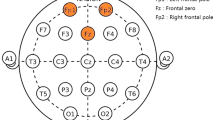Abstract
This study is aimed to compare sensitivity of different electroencephalographic (EEG) indicators for detection of depression. The novel EEG spectral asymmetry index (SASI) was introduced based on balance between the powers of two special EEG frequency bands selected lower and higher of the EEG spectrum maximum and excluding the central frequency from the calculations. The efficiency of the SASI was compared to the traditional EEG inter-hemispheric asymmetry and coherence methods. EEG recordings were carried out on groups of depressive and healthy subjects of 18 female volunteers each. The resting eight-channel EEG was recorded during 30 min. The SASI calculated in an arbitrary EEG channel differentiated clearly between the depressive and healthy group (p < 0.005). Correlation between SASI and Hamilton Depression Rating Scale score was 0.7. The EEG inter-hemispheric asymmetry and coherence revealed some trends, but no significant differences between the groups of healthy controls and patients with depressive disorder.






Similar content being viewed by others
References
Henderson G, Ifeachor E, Hudson N et al (2006) Development and assessment of methods for detecting dementia using the human electroencephalogram. IEEE Trans Biomed Eng 53:1557–1568
Shen KQ, Li XP, Ong CJ, Shao SY, Wilder-Smith EP (2008) EEG-based mental fatigue measurement using multi-class support vector machines with confidence estimate. Clin Neurophysiol 119:1524–1533
Adeli H, Ghosh-Dastidar S, Dadmehr N (2008) A spatio-temporal wavelet-chaos methodology for EEG-based diagnosis of Alzheimer’s disease. Neurosci Lett 444:190–194
Abasolo D, Escudero J, Hornero R, Gomez C, Espino P (2008) Approximate entropy and auto mutual information analysis of the electroencephalogram in Alzheimer’s disease patients. Med Biol Eng Comp 46:1019–1028
Lehmann C, Koenig T, Jelic V, Prichep L, John R (2007) Application and comparison of classifications algorithms for recognition of Alzheimer’s disease in electrical brain activity (EEG). J Neurosci Methods 161:342–350
Allen JB, Urry HL, Hitt SK, Coan JA (2004) The stability of resting frontal electroencephalographic asymmetry in depression. Psychophysiology 41:269–275
Henriques JB, Davidson RJ (1991) Left frontal hypoactivation in depression. J Abnorm Psychol 100:535–545
Knott V, Mahoney C, Kennedy S, Evans K (2001) EEG power, frequency, asymmetry and coherence in male depression. Psychiatry Res Neuroimaging 106:123–140
Lubar JF, Congedo M, Askew JH (2003) Low-resolution electromagnetic tomography (LORETA) of cerebral activity in chronic depressive disorder. Int J Psychopathol 49:175–185
Mathersul D, Williams L, Hopkinson P, Kemp A (2008) Investigating models of affect: relationships among EEG alpha asymmetry, depression, and anxiety. Emotion 8:560–572
Pop-Jordanova N, Pop-Jordanov J (2005) Spectrum-weighted EEG frequency (“brain-rate”) as a quantitative indicator of mental arousal. Prilozi 26:35–42
Ricardo-Garcell J, Gonzalez-Olvera J, Miranda E et al (2009) EEG sources in a group of patients with major depressive disorder. Int J Psychophysiol 71:70–74
Reid SA, Duke LM, Allen JJB (1998) Resting frontal electroencephalographic asymmetry in depression: in consistencies suggest the need to identify mediating factors. Psychophysiology 35:389–404
Debener S, Beauducel A, Nessler D, Brocke B, Heilemann H, Kavser J (2000) Is resting anterior EEG alpha asymmetry a trait marker for depression? Findings for healthy adults and clinically depressed patients. Neuropsychobiology 41:31–37
Sun Y, Li Y, Zhu Y, Chen X, Tong S (2008) Electroencephalographic differences between depressed and control subjects: an aspect of interdependence analysis. Brain Res Bull 76:559–564
Huupponen E, Saunamäki T, Saastamoinen A, Kulkas A, Tenhunen M, Himanen S-L (2009) Improved computational fronto-central sleep depth parameters show differences between apnea patients and control subjects. Med Biol Eng Comput 47:3–10
Temuçin CM, Tokçaer AB, Bilir E (2005) Detection of EEG background abnormalities in epilepsy by a new spectral index. Clin Neurophysiol 116:933–947
Van Putten MJ (2007) The revised brain symmetry index. Clin Neurophysiol 118:2362–2367
Bachmann M, Kalda J, Lass J, Tuulik V, Sakki M, Hinrikus H (2005) Non-linear analysis of the electroencephalogram for detecting effects of low-level electromagnetic fields. Med Biol Eng Comp 43:142–149
Bachmann M, Hinrikus H, Aadamsoo K, Võhma Ü, Lass J, Rubljova J, Suhhova A, Tuulik V (2007) Modulated microwave effects on individuals with depressive disorder. Environmentalist 27:505–510
Towers DN, Allen JJ (2009) A better estimate of the internal consistency reliability of frontal EEG asymmetry scores. Psychophysiology 46:132–142
Hinrikus H, Bachmann M, Lass J, Suhhova A, Tuulik V, Aadamsoo K, Vohma Y (2009) Method and device for determining depressive disorders by measuring bioelectromagnetic signals of the brain. US 2009/0054801/A1 from Feb 26, 2009
National Institute of Mental Health (2008) The numbers count: mental disorders in America. Describes statistics about mental disorders. http://www.nimh.nih.gov/health/publications/the-numbers-count-mental-disorders-in-america
Flor-Henry P, Lind JC, Koles ZJ (2004) A source-imaging (low-resolution electromagnetic tomography) study of the EEGs from unmedicated males with depression. Psychiatry Res Neuroimaging 109:191–207
Acknowledgments
This study was supported by the Estonian Science Foundation Grant No 6632, by the Estonian targeted financing project SF0140027s07, and by the European Union through the European Regional Development Fund.
Author information
Authors and Affiliations
Corresponding author
Rights and permissions
About this article
Cite this article
Hinrikus, H., Suhhova, A., Bachmann, M. et al. Electroencephalographic spectral asymmetry index for detection of depression. Med Biol Eng Comput 47, 1291–1299 (2009). https://doi.org/10.1007/s11517-009-0554-9
Received:
Accepted:
Published:
Issue Date:
DOI: https://doi.org/10.1007/s11517-009-0554-9




